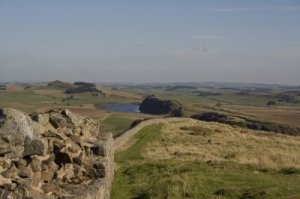Hadrian’s Wall is one of the most popular tourist attractions in the north of England. With construction starting in AD 122, during the rule of Emperor Hadrian, Hadrian’s Wall extends west, for 80 Roman miles (73 statute miles or 120 km), from Segedunum at Wallsend on the banks of the River Tyne in Newcastle upon Tyne to the shores of the Solway Firth, at Bowness on Solway, in Cumbria. The wall was largely completed by AD 128.
There is a common misconception that Hadrian’s Wall denoted the boundary between England and Scotland. This is not the case and is believed the wall was constructed to denote the northern extremity of the Roman Empire at that time, to reflect the power of Rome, and was used as a political point by Hadrian. However, the boundary was pushed further north in AD142 with the building of the Antonine Wall between the Firth of Forth and the Firth of Clyde in Scotland thereby this represented the northern most frontier barrier of the Roman Empire of all time, albeit for a short time as this wall was only in use for about 20 years, and the garrisons relocated back to Hadrian's Wall. Hadrian’s Wall remained occupied by Roman troops until their withdrawal from Britain around AD 410.
Even though the wall was the most fortified border in the Roman Empire, it not only served as a military fortification it also controlled cross border trade and immigration. As the wall had many gates, usually located within the milecastles, it would have served as a “customs” post.
Thanks to the Victorian, John Clayton, in the 19th Century, a significant portion of the wall still exists today, and his artefacts can still be seen today in the museum at Chesters Roman Fort. These remaining sections can be enjoyed by those walking the 84 miles of the Hadrian's Wall Path National Trail, which follows most of the walls length or by cycling on the Sustrans promoted National Cycle Route 72, the Hadrian’s Cycleway.
The Hadrian’s Wall corridor, which also includes the system of milecastles and turrets that continue west, from Bowness on Solway, along the Cumbria Coast as far as Maryport was made a UNESCO World Heritage Site in 1987 and in 2005 it became part of the transnational "Frontiers of the Roman Empire" World Heritage Site which also includes sites in Germany. The World Heritage Site and Hadrian’s Wall Path National Trail are managed by the Hadrian’s Wall Trust, based in Hexham.
Here in the Heart of Hadrian's Wall you can explore interesting and intriguing Roman sites as well as experiencing some of the best preserved sections of Hadrian's Wall.



